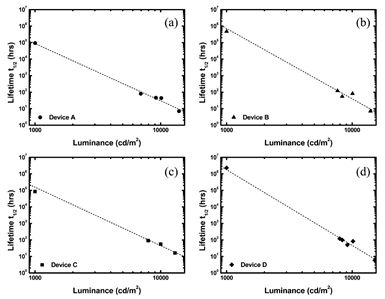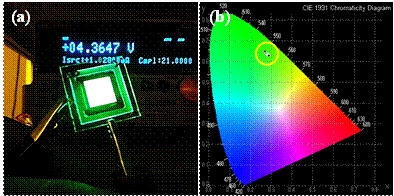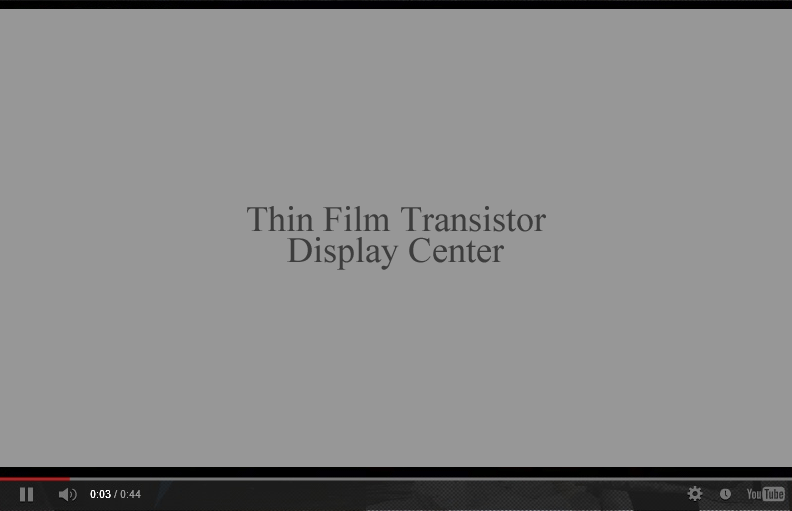Organic light emitting diodes (OLEDs) are light sources, which are used for lighting and displays. OLED displays (also called AM-OLED displays, which is short for active matrix OLED) for mobile devices are currently the most technologically advanced application of organic electronics.
Solution processed polymer light-emitting diodes (PLEDs) are of increasing interest because they provide many advantages, including low-cost processing and mechanical flexibility. Typical PLEDs consist of two layers; a hole injection layer (HIL) and an emission layer (EML). These two layers are sandwiched by two electrodes; an opaque cathode (typically Al) and a transparent anode (indium tin oxide (ITO)).
As solution processed PLED, we studied the effect of the solution processed tungsten oxide (WOx) as a anode buffer on the performance and stability of a PLED. Solution processing is cheap, simple and does not require high temperatures, which makes it suitable for PLEDs and flexible substrates. As a results, we could make a device which had long lifetime and stability [Fig 1 and 2].

Figure 1. (a) Energy band diagram of PLEDs used in this work using WOx and (b) schematic structure of PLEDs
[Jun-Ho Youn, Su-Jin Baek, Hyeong-Pil Kim, Dong-Hee Nam, Young-Gu Lee, Jueng-Gil Lee and Jin Jang. J. Mater. Chem. C, 2013,1, 3250]

Figure 2. Measured lifetime (t1/2) as a function of initial luminance for (a) devices A (circles), (b) B (triangles),
(c) C (rectangles) and (d) D (diamonds). Lifetimes at 1000 cd/m2 fall closely to the regression lines,
verifying the accuracy of extracted values
[Jun-Ho Youn, Su-Jin Baek, Hyeong-Pil Kim, Dong-Hee Nam, Young-Gu Lee, Jueng-Gil Lee and Jin Jang. J. Mater. Chem. C, 2013,1, 3250]
Since Tang and VanSlyke developed an efficient OLED based on an organic bilayer structure in 1987, the efficiency has been perpetually increasing. Particularly, the use of n- and p-doped organic transport materials in small-molecule OLEDs lead to improved conductivities and significantly better injection of charge carriers into the OLED. As a result, OLEDs with elevated power efficiencies have been realized. Further concepts have been established such as the insertion of additional organic layers as exciton and charge carrier blockers localizing the emission zone and preventing exciton quenching effects as well as charge carrier imbalance. In additon, approaches to lower the energy barriers for efficient hole injection and transportation to the emission zone have been pursued.
As small molecule OLED, we develop a highly efficient OLED for applying to large area display panel [Fig 3 and 4]. Our major aim in OLED research is improvement of device performance by characteristic evaluation of doping material, design, optimization and application of new structures.

Figure 3. Device characteristic of small molecule OLED. (a) Luminance -voltage and (b) current efficiency - luminance

Figure 4. (a) Operating image and (b) CIE coordinate of small molecule OLED
References:
[1] Jun-Ho Youn, Su-Jin Baek, Hyeong-Pil Kim, Dong-Hee Nam, Young-Gu Lee, Jueng-Gil Lee and Jin Jang. Jour. Mater. Chem. C. 2013, 19, 3250
[2] Wilson Jose da Silva, Abd. Rashid bin Mohd Yusoff and Jin Jang. Revised
[3] C. W. Tang and S. A. VanSlyke, Appl. Phys. Lett. 1987, 51, 12.
[4] J. Kido and T. Matsumoto, Appl. Phys. Lett. 1998, 73, 2866.
[5] X. Zhou, J. Blochwitz, M. Pfeiffer, A. Nollau, T. Fritz, and K. Leo, Adv. Funct. Mater. 2001, 11, 4.
[6] M. A. Baldo, S. Lamansky, P. E. Burrows, and M. E. Thompson, Appl. Phys. Lett. 1999, 75, 4.





















































